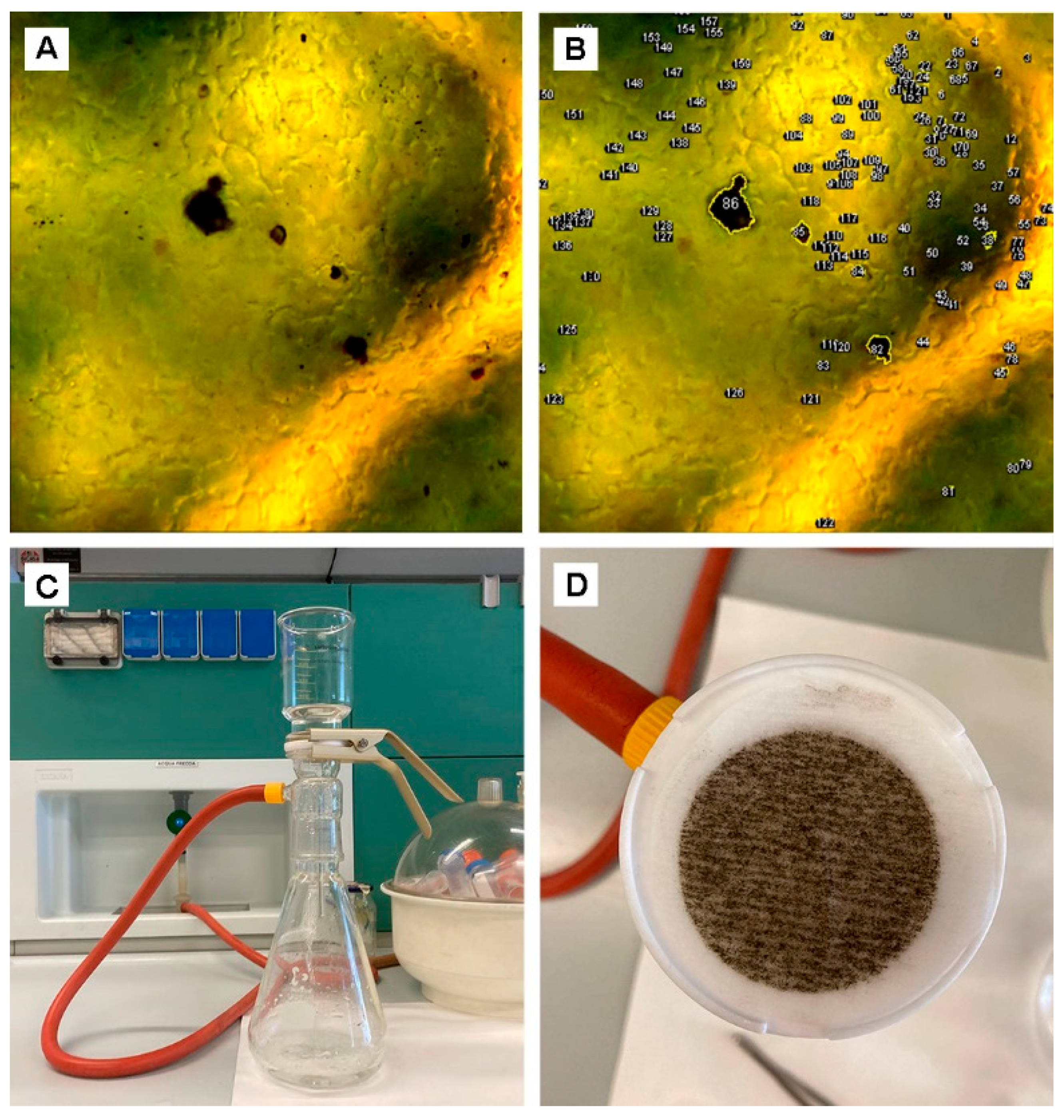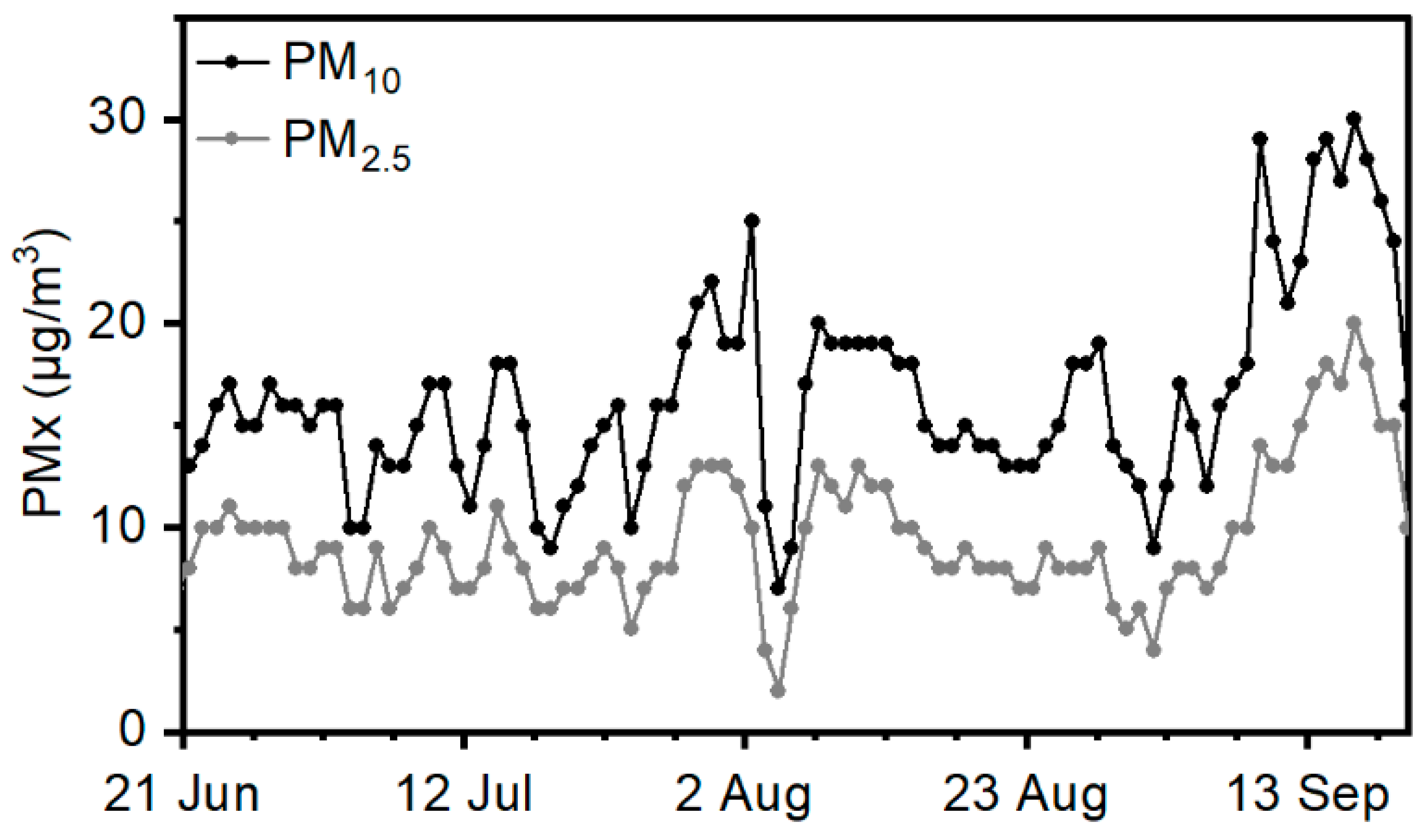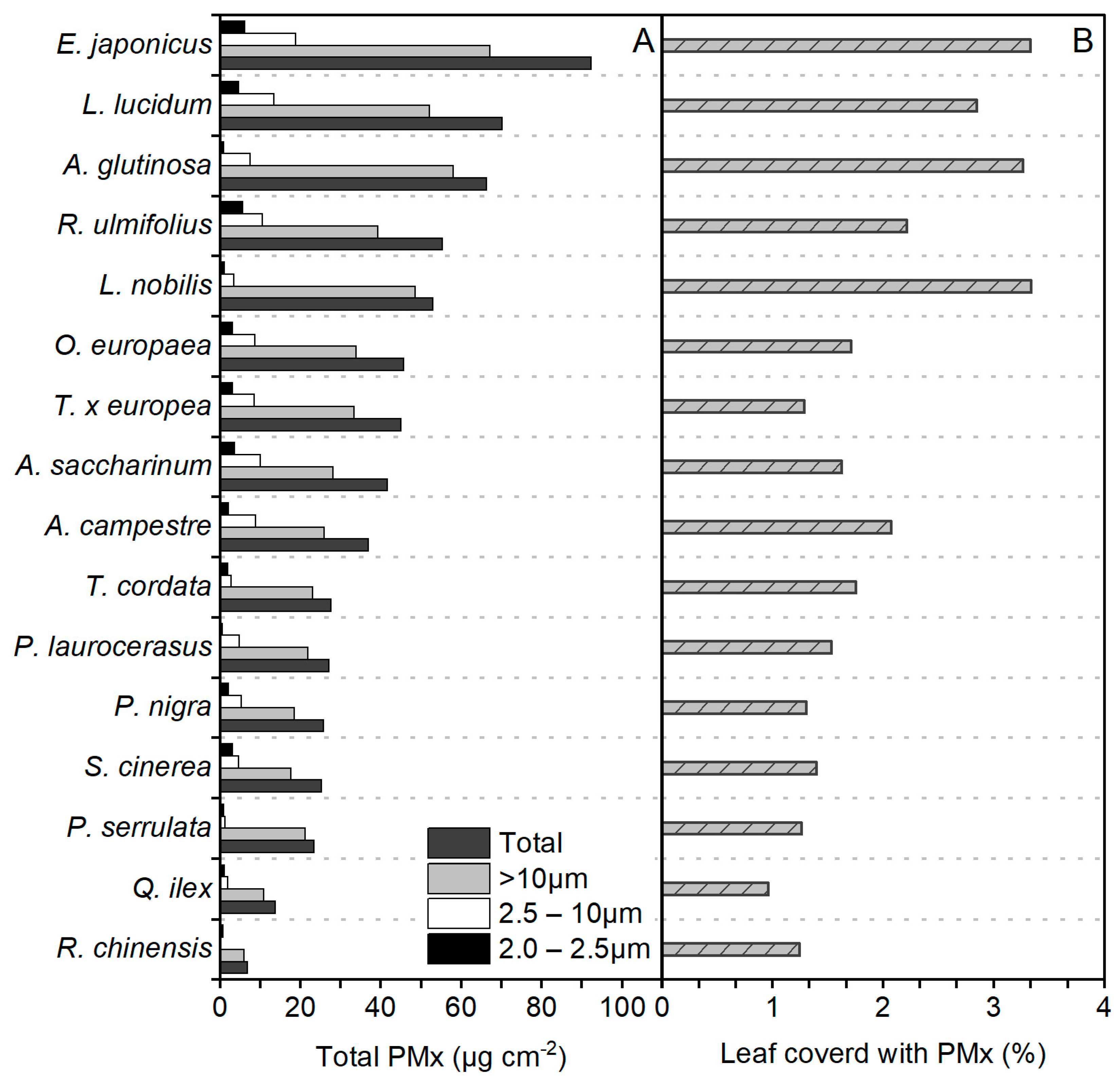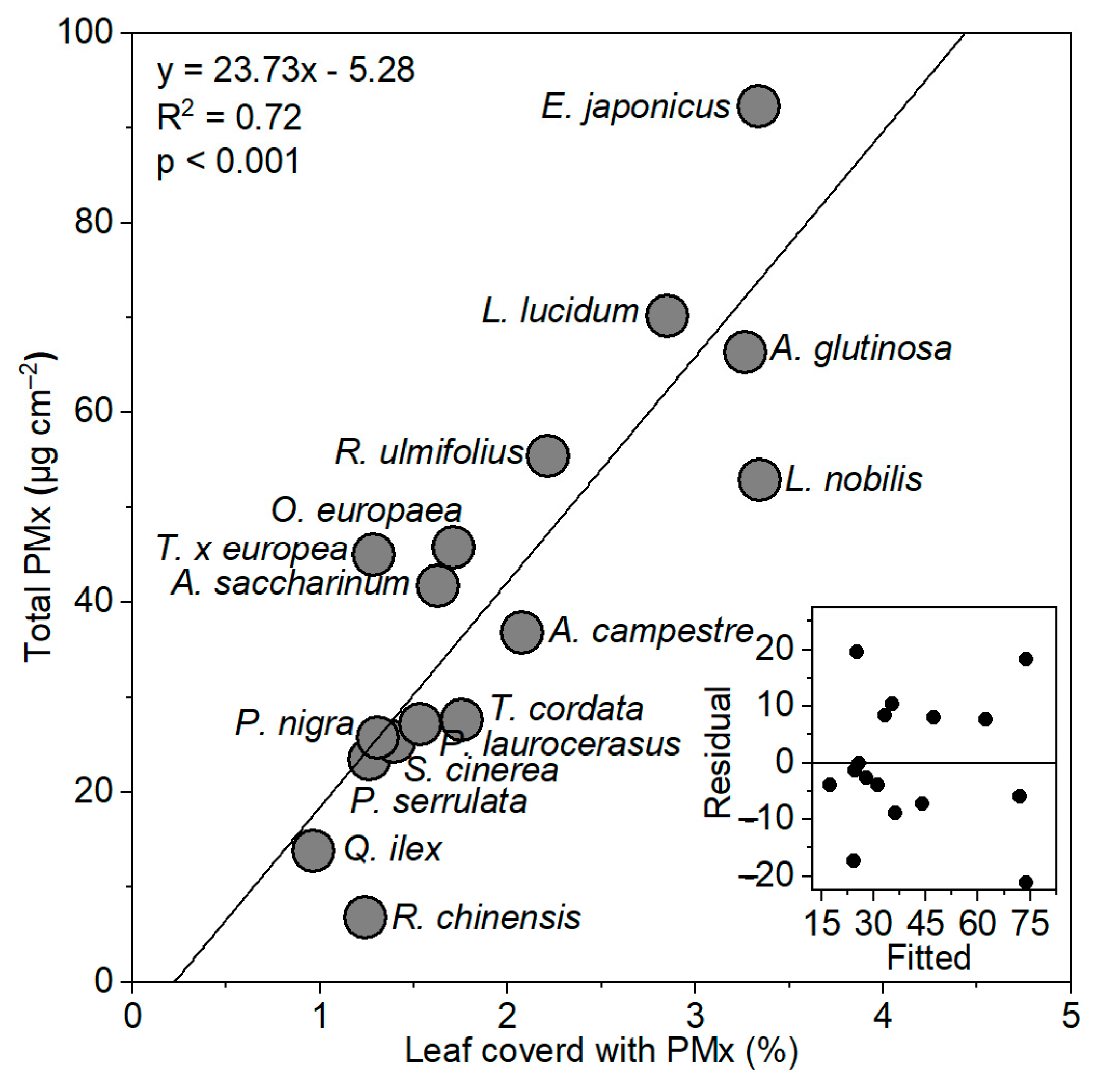Comparing Different Methodologies to Quantify Particulate Matter Accumulation on Plant Leaves
Abstract
:1. Introduction
2. Material and Methods
2.1. Study Area
2.2. Plant Species
2.3. The Leaf Covering by PMx Using Light Microscopy
2.4. The Filtration Methodology [9]
2.5. Leaf Traits
2.6. Statistical Analysis
3. Results
4. Discussion
5. Conclusions
Author Contributions
Funding
Institutional Review Board Statement
Informed Consent Statement
Data Availability Statement
Acknowledgments
Conflicts of Interest
References
- Sawidis, T.; Breuste, J.; Mitrovic, M.; Pavlovic, P.; Tsigaridas, K. Trees as bioindicator of heavy metal pollution in three European cities. Environ. Pollut. 2011, 159, 3560–3570. [Google Scholar] [CrossRef] [PubMed]
- European Environment Agency. 2023. Available online: https://www.eea.europa.eu/themes/air/country-fact-sheets/2023-country-fact-sheets/italy-air-pollution-country (accessed on 5 February 2024).
- Bell, M.L.; Morgenstern, R.D.; Harrington, W. Quantifying the human health benefits of air pollution policies: Review of recent studies and new directions in accountability research. Environ. Sci. Policy 2011, 14, 357–368. [Google Scholar] [CrossRef]
- Suzuki, K. Characterisation of airborne particulates and associated trace metals deposited on tree bark by ICP-OES, ICP-MS, SEM-EDX and laser ablation ICP-MS. Atmos. Environ. 2006, 40, 2626–2634. [Google Scholar] [CrossRef]
- Lunghi, J.; Malpede, M.; Reis, L.A. Exploring the impact of livestock on air quality: A deep dive into Ammonia and particulate matter in Lombardy. Environ. Impact Assess. Rev. 2024, 105, 107456. [Google Scholar] [CrossRef]
- Beckett, K.P.; Freer-Smith, P.H.; Taylor, G. Urban woodlands: Their role in reducing the effects of particulate pollution. Environ. Pollut. 1998, 99, 347–360. [Google Scholar] [CrossRef] [PubMed]
- Lin, L.; Yan, J.; Ma, K.; Zhou, W.; Chen, G.; Tang, R.; Zhang, Y. Characterization of particulate matter deposited on urban tree foliage: A landscape analysis approach. Atmos. Environ. 2017, 171, 59–69. [Google Scholar] [CrossRef]
- Jones, L.; Vieno, M.; Fitch, A.; Carnell, E.; Steadman, C.; Cryle, P.; Holland, M.; Nemitz, E.; Morton, D.; Hall, J.; et al. Urban natural capital accounts: Developing a novel approach to quantify air pollution removal by vegetation. J. Environ. Econ. Policy 2019, 8, 413–428. [Google Scholar] [CrossRef]
- Mori, J.; Fini, A.; Galimberti, M.; Ginepro, M.; Burchi, G.; Massa, D.; Ferrini, F. Air pollution deposition on a roadside vegetation barrier in a Mediterranean environment: Combined effect of evergreen shrub species and planting density. Sci. Total Environ. 2018, 643, 725–737. [Google Scholar] [CrossRef]
- Nowak, D.J.; Hirabayashi, S.; Bodine, A.; Greenfield, E. Tree and forest effects on air quality and human health in the United States. Environ. Pollut. 2014, 193, 119–129. [Google Scholar] [CrossRef]
- Hashad, K.; Gu, J.; Yang, B.; Rong, M.; Chen, E.; Ma, X.; Zhang, K.M. Designing roadside green infrastructure to mitigate traffic-related air pollution using machine learning. Sci. Total Environ. 2021, 773, 144760. [Google Scholar] [CrossRef]
- Moura, B.B.; Zammarchi, F.; Manzini, J.; Yasutomo, H.; Brilli, L.; Vagnoli, C.; Gioli, B.; Zaldei, A.; Giordano, T.; Martinelli, F.; et al. Assessment of seasonal variations in particulate matter accumulation and elemental composition in urban tree species. Environ. Res. 2024, 252, 118782. [Google Scholar] [CrossRef] [PubMed]
- Sæbø, A.; Popek, R.; Nawrot, B.; Hanslin, H.M.; Gawronska, H.; Gawronski, S.W. Plant species differences in particulate matter accumulation on leaf surfaces. Sci. Total Environ. 2012, 427–428, 347–354. [Google Scholar] [CrossRef]
- Muhammad, S.; Wuyts, K.; Samson, R. Atmospheric net particle accumulation on 96 plant species with contrasting morphological and anatomical leaf characteristics in a typical garden experiment. Atmos. Environ. 2019, 202, 328–344. [Google Scholar] [CrossRef]
- Popek, R.; Przybysz, A.; Gawrońska, H.; Klamkowski, K.; Gawroński, S.W. Impact of particulate matter accumulation on the photosynthetic apparatus of roadside woody plants growing in the urban conditions. Ecotoxicol. Environ. Saf. 2018, 163, 56–62. [Google Scholar] [CrossRef]
- Steinparzer, M.; Schaubmayr, J.; Godbold, D.L.; Rewald, B. Particulate matter accumulation by tree foliage is driven by leaf habit types, urbanization-and pollution levels. Environ. Pollut. 2023, 335, 122289. [Google Scholar] [CrossRef]
- Brilli, L.; Carotenuto, F.; Andreini, B.P.; Cavaliere, A.; Esposito, A.; Gioli, B.; Martelli, F.; Stefanelli, M.; Vagnoli, C.; Venturi, S.; et al. Low-cost air quality stations’ capability to integrate reference stations in particulate matter dynamics assessment. Atmosphere 2021, 12, 1065. [Google Scholar] [CrossRef]
- Gualtieri, G.; Toscano, P.; Crisci, A.; Di Lonardo, S.; Tartaglia, M.; Vagnoli, C.; Zaldei, A.; Gioli, B. Influence of road traffic, residential heating and meteorological conditions on PM10 concentrations during air pollution critical episodes. Environ. Sci. Pollut. Res. 2015, 22, 19027–19038. [Google Scholar] [CrossRef] [PubMed]
- Schneider, C.A.; Rasband, W.S.; Eliceiri, K.W. NIH Image to ImageJ: 25 years of image analysis. Nat. Methods 2012, 9, 671–675. [Google Scholar] [CrossRef]
- Mori, J.; Sæbø, A.; Hanslin, H.M.; Teani, A.; Ferrini, F.; Fini, A.; Burchi, G. Deposition of traffic-related air pollutants on leaves of six evergreen shrub species during a Mediterranean summer season. Urban For. Urban Green. 2015, 14, 264–273. [Google Scholar] [CrossRef]
- Blanuša, T.; Qadir, Z.J.; Kaur, A.; Hadley, J.; Gush, M.B. Evaluating the effectiveness of urban hedges as air pollution barriers: Importance of sampling method, species characteristics and site location. Environments 2020, 7, 81. [Google Scholar] [CrossRef]
- Przybysz, A.; Popek, R.; Stankiewicz-Kosyl, M.; Zhu, C.Y.; Małecka-Przybysz, M.; Maulidyawati, T.; Mikowska, K.; Deluga, D.; Griżuk, K.; Sokalski-Wieczorek, J.; et al. Where trees cannot grow—Particulate matter accumulation by urban meadows. Sci. Total Environ. 2021, 785, 147310. [Google Scholar] [CrossRef]
- Beckett, K.P.; Freer-Smith, P.H.; Taylor, G. Particulate pollution capture by urban trees: Effect of species and windspeed. Glob. Change Biol. 2000, 6, 995–1003. [Google Scholar] [CrossRef]
- Freer-Smith, P.H.; Beckett, K.P.; Taylor, G. Deposition velocities to Sorbus aria, Acer campestre, Populus deltoides × trichocarpa “Beaupré”, Pinus nigra and × Cupressocyparis leylandii for coarse, fine and ultra-fine particles in the urban environment. Environ. Pollut. 2005, 133, 157–167. [Google Scholar] [CrossRef]
- Manzini, J.; Hoshika, Y.; Carrari, E.; Sicard, P.; Watanabe, M.; Tanaka, R.; Badea, O.; Nicese, F.P.; Ferrini, F.; Paoletti, E. FlorTree: A unifying modelling framework for estimating the species-specific pollution removal by individual trees and shrubs. Urban For. Urban Green. 2023, 85, 127967. [Google Scholar] [CrossRef]
- Prigioniero, A.; Postiglione, A.; Zuzolo, D.; Niinemets, Ü.; Tartaglia, M.; Scarano, P.; Mercurio, M.; Germinario, C.; Izzo, F.; Trifuoggi, M.; et al. Leaf surface functional traits influence particulate matter and polycyclic aromatic hydrocarbons air pollution mitigation: Insights from Mediterranean urban forests. J. Clean. Prod. 2023, 418, 138158. [Google Scholar] [CrossRef]
- Kwak, M.J.; Lee, J.K.; Park, S.; Kim, H.; Lim, Y.J.; Lee, K.A.; Son, J.-A.; Oh, C.-Y.; Kim, I.; Woo, S.Y. Surface-based analysis of leaf microstructures for adsorbing and retaining capability of airborne particulate matter in ten woody species. Forests 2020, 11, 946. [Google Scholar] [CrossRef]
- Wuytack, T.; Wuyts, K.; Van Dongen, S.; Baeten, L.; Kardel, F.; Verheyen, K.; Samson, R. The effect of air pollution and other environmental stressors on leaf fluctuating asymmetry and specific leaf area of Salix alba L. Environ. Pollut. 2011, 159, 2405–2411. [Google Scholar] [CrossRef]
- Moura, B.B.; Alves, E.S. Climatic factors influence leaf structure and thereby affect the ozone sensitivity of Ipomoea nil “Scarlet O’Hara”. Environ. Pollut. 2014, 194, 11–16. [Google Scholar] [CrossRef]
- Xie, C.; Guo, J.; Yan, L.; Jiang, R.; Liang, A.; Che, S. The influence of plant morphological structure characteristics on PM2.5 retention of leaves under different wind speeds. Urban For. Urban Green. 2022, 71, 127556. [Google Scholar] [CrossRef]




| Species | Family Name | Type of Plant |
|---|---|---|
| Acer campestre L. | Sapindaceae | Tree |
| Acer negundo L. | Sapindaceae | Tree |
| Acer saccharinum L. | Sapindaceae | Tree |
| Alnus glutinosa (L.) Gaertn. | Betulaceae | Tree |
| Celtis australis L. | Cannabaceae | Tree |
| Euonymus japonicus Thunb. | Celastraceae | Shrub |
| Forsythia viridissima Lindl. | Oleaceae | Shrub |
| Gaultheria procumbens L. | Ericaceae | Shrub |
| Ginkgo biloba L. | Ginkgoaceae | Tree |
| Impatiens walleriana Hook.f. | Balsaminaceae | Herb |
| Laurus nobilis L. | Lauraceae | Shrub |
| Lavandula latifolia Medik. | Lamiaceae | Shrub |
| Ligustrum lucidum W.T. Aiton | Oleaceae | Tree |
| Nerium oleander L. | Apocynaceae | Shrub |
| Olea europaea L. | Oleaceae | Tree |
| Populus alba L. | Salicaceae | Tree |
| Populus nigra L. | Salicaceae | Tree |
| Prunus domestica L. | Rosaceae | Tree |
| Prunus laurocerasus L. | Rosaceae | Tree |
| Prunus serrulata Lindl. | Rosaceae | Tree |
| Quercus ilex L. | Fagaceae | Tree |
| Rosa chinensis Jacq. | Rosaceae | Shrub |
| Rubus ulmifolius Schott | Rosaceae | Shrub |
| Salix cinerea L. | Salicaceae | Shrub or tree |
| Styphnolobium japonicum (L.) Schott | Fabaceae | Tree |
| Tilia x europaea L. | Malvaceae | Tree |
| Tilia cordata Mill. | Malvaceae | Tree |
| Ulmus minor Mill. | Ulmaceae | Tree |
| Ulmus glabra Huds. | Ulmaceae | Tree |
| Viburnum spp. | Viburnaceae | Shrub |
| Part 1 | Species | LA | SLA | LDI | Leaf Roundness |
| E. japonicus | 5.59 | 7.49 | 6.35 | 0.62 | |
| L. lucidum | 27.57 | 6.49 | 5.00 | 0.43 | |
| A. glutinosa | 54.81 | 14.03 | 5.53 | 1.00 | |
| R. ulmifolius | 6.37 | 9.29 | 4.97 | 0.39 | |
| L. nobilis | 19.27 | 8.17 | 5.16 | 0.29 | |
| O. europaea | 5.19 | 7.15 | 6.60 | 0.17 | |
| Tilia x europaea | 47.39 | 18.69 | 6.65 | 0.83 | |
| A. saccharinum | 46.63 | 12.65 | 12.29 | 0.50 | |
| A. campestre | 32.85 | 14.22 | 5.79 | 0.68 | |
| T. cordata | 75.56 | 15.95 | 6.13 | 0.99 | |
| P. laurocerasus | 85.48 | 8.52 | 5.09 | 0.36 | |
| P. nigra | 39.02 | 12.08 | 7.29 | 0.77 | |
| S. cinerea | 33.44 | 9.72 | 6.04 | 0.45 | |
| P. serrulata | 29.42 | 8.17 | 4.85 | 0.56 | |
| Q. ilex | 12.11 | 9.57 | 5.42 | 0.41 | |
| R. chinensis | 8.21 | 21.20 | 4.71 | 0.60 | |
| Part 2 | Variable | Correlation | R2 | p-Level | |
| % PMx | LA | - | 0.26 | 0.072 | |
| SLA | - | 0.69 | 0.022 | ||
| LDI | ni | 0.52 | 0.422 | ||
| Leaf roundness | + | 0.66 | 0.016 | ||
| Total PMx | LA | ni | 0.26 | 0.104 | |
| SLA | - | 0.69 | 0.093 | ||
| LDI | ni | 0.52 | 0.551 | ||
| Leaf roundness | ni | 0.66 | 0.152 | ||
| PM10 | LA | ni | 0.26 | 0.188 | |
| SLA | ni | 0.69 | 0.112 | ||
| LDI | ni | 0.52 | 0.809 | ||
| Leaf roundness | ni | 0.66 | 0.121 | ||
| PM2.5 | LA | - | 0.26 | 0.034 | |
| SLA | - | 0.69 | 0.072 | ||
| LDI | + | 0.52 | 0.099 | ||
| Leaf roundness | ni | 0.66 | 0.745 | ||
| PM0.2 | LA | - | 0.26 | 0.054 | |
| SLA | ni | 0.69 | 0.541 | ||
| LDI | ni | 0.52 | 0.347 | ||
| Leaf roundness | ni | 0.66 | 0.655 |
Disclaimer/Publisher’s Note: The statements, opinions and data contained in all publications are solely those of the individual author(s) and contributor(s) and not of MDPI and/or the editor(s). MDPI and/or the editor(s) disclaim responsibility for any injury to people or property resulting from any ideas, methods, instructions or products referred to in the content. |
© 2024 by the authors. Licensee MDPI, Basel, Switzerland. This article is an open access article distributed under the terms and conditions of the Creative Commons Attribution (CC BY) license (https://creativecommons.org/licenses/by/4.0/).
Share and Cite
Baesso Moura, B.; Zammarchi, F.; Hoshika, Y.; Martinelli, F.; Paoletti, E.; Ferrini, F. Comparing Different Methodologies to Quantify Particulate Matter Accumulation on Plant Leaves. Urban Sci. 2024, 8, 125. https://doi.org/10.3390/urbansci8030125
Baesso Moura B, Zammarchi F, Hoshika Y, Martinelli F, Paoletti E, Ferrini F. Comparing Different Methodologies to Quantify Particulate Matter Accumulation on Plant Leaves. Urban Science. 2024; 8(3):125. https://doi.org/10.3390/urbansci8030125
Chicago/Turabian StyleBaesso Moura, Barbara, Francesco Zammarchi, Yasutomo Hoshika, Federico Martinelli, Elena Paoletti, and Francesco Ferrini. 2024. "Comparing Different Methodologies to Quantify Particulate Matter Accumulation on Plant Leaves" Urban Science 8, no. 3: 125. https://doi.org/10.3390/urbansci8030125







